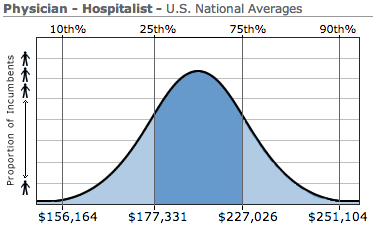A hospitalist is a physician who works primarily in the hospital serving acutely ill patients. The term was first coined in 1996 by a couple of doctors writing in the New England Journal of Medicine. Since then, the movement has persistently grown to encompass the majority of hospitals in the United States. Over 34,000 hospitalists are estimated to be working in the US as of 2012.
Back in the old days, a primary care physician did double duty : they saw patients in the office as well as in the hospital. Whenever one of their 2,500 patients (the average patient panel size in the US) was very sick, the patient would be admitted to the hospital and the primary doctor would be overseeing the care there as well. But, duty hour limitations, work/life balance, and even consideration of revenue has led most primary care doctors to leave hospital medicine behind. And thus, it opened the door for this new kind of medicine to blossom.
What are the benefits of hospital medicine? More money, better schedules, more immediate results and better support (via consults and labs/imaging all there at the hospital). By better schedules, I simply mean there are more options for scheduling and balancing life with work. Some hospitalists work 7 days on followed by 7 days off. Some work a block of time at a time. Others might do shift work and others might be traditional with call duties.
Just how much do hospitalists make?
The median expected salary is $200,579 according to Salary.com. However, the MGMA reports the median as $233,855. Another body called Today’s Hospitalist conducted their own limited survey and found that the salary ranges very widely with some hospitalists making over $300,000 in annual income.
There are two main kinds of hospitalists : adult medicine and pediatric medicine. However, specialists are catching on to the idea as well and making a shift segregating their office from their hospital duties.
The majority of adult hospitalists have internal medicine residency training. The majority of pediatric hospitalists have pediatric residency training. Those are 3 years each. Fellowships are not required but are available should you want one.
Now, family medicine can become hospitalists too but they are not as well qualified from the eyes of a hospitalist human resources recruitment perspective. Why? It has to do with the amount of in-hospital training one receives while in residency. Without a doubt, internal medicine residents do more hospital work than office work. Also, family medicine residency appropriately divides your time in pediatrics and obgyn further decreasing the potential for adult in-patient hospital medicine training. With that said, you could always tailor your 2nd and 3rd yr electives to get more training in in-patient medicine.
To increase your chances of getting a hospitalist job as a family medicine physician, consider getting more experience in hospital medicine by choosing residencies which offer a hospitalist track or do a fellowship in hospital medicine for an extra year or two.
Hospital medicine is here to stay and it is growing more popular by the year. The lure of higher salary and potentially better work schedules draws many physicians to consider this kind of position. If you enjoy working in a hospital, the immediacy of getting a lab or image result to direct care, the challenge of very, very sick patients, then you might enjoy being a hospitalist.





If you are interested in some more date on hospitalists’ salaries, check out our Career & Compensation Survey http://www.todayshospitalist.com/index.php?b=salary_survey_results